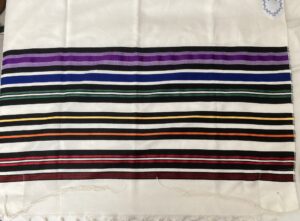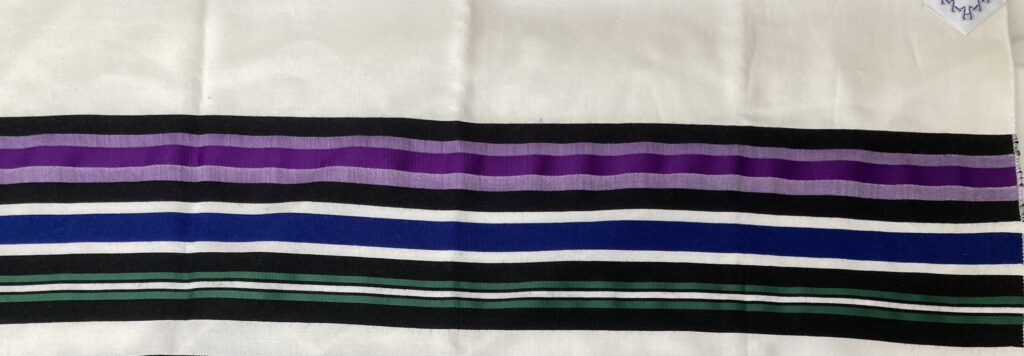Tallit of Rainbow Light
I have met many Jews in many kinds of shuls who wear a Tallit which was designed by Reb Zalman in the 1950’s. When I pointed this out, most of them didn’t know its background and history and so, I’ve decided to share it here. Much of what I wrote below is taken directly from an interview of Reb Zalman by Rabbi Yonassan Gershom from around forty years ago. Gabbai Seth Fishman
The Midrash (Bereishit Rabbah 3:4) teaches us:
“From what was the light created? A text teaches that the Holy One blessed be He enwrapped Himself in light like a garment, and the aura of its radiance shone from one end of the world to the other.”
The text referenced is:
(Psalm 104:1-2) “Yah, my God, You are very great; You are attired with beauty and majesty, You enwrap Yourself in a robe of light; You spread the heavens like a curtain.”
It was this text that inspired Reb Zalman to envision a Tallit with colors.
Yonassan: So, you had in mind that the ‘robe of light’ mentioned in the Midrash is the spectrum; that spectrum is literally the Primal Light?
Zalman: Right. And the spectrum itself has black lines, too, as one sees on a spectroscope.
Z: Once I started to visualize it, I asked myself which of the colors should have the black lines? I saw the black lines as kelim / vessels which held the colors, the Sefirot of Creation. Which of the Sefirot need to be contained? Which stripes should be wide and which narrow? And what should the spacing be? So it came out like this:
KETER, CHOKHMAH, BINAH
CHESED, GEVURAH, TIFERET
- The Atarah / embroidered-strip of the Tallit corresponds to Keter / Crown, Source of the White Light, which enters into Chochmah-Binah / Wisdom-Understanding still white.
- Then Chesed / Lovingkindness, a wide purple stripe. There are two shades of purple since it corresponds to the First Day of Creation, the deep purple represents ultra-violet, just coming out of darkness and the lighter lavender, on either side of the deep purple already has some light mixed in, like the first light becoming visible to the human eye. The whole stripe is very wide, because the nature of Chesed is broad and sweeping and this is why it also needs the black lines to contain it.
- The next stripe is Blue-Techelet, representing Gevurah / Rigor and it corresponds to the Second Day of Creation, when the waters above were separated from the waters below. Gevurah also represents halachah which is already, by nature, a container so it didn’t need black stripes to border it.
- The next stripe, Tiferet / Balance or Harmony, corresponds to the Third Day. Vegetation was created then, and this is represented by Green. G-d said “It is good,” twice on that day, so there are two green stripes, with the white light of Keter coming through the middle. It corresponds to the heart chakra, which needs strong boundaries, so there are black lines bordering it.
NETZACH, HOD, YESOD
- Next comes Netzach / Persistence, the Fourth Day, when the sun, moon, and stars were created, so it is represented by Yellow.
- Next is Hod / Beauty, the Fifth Day when egg-laying animals were made: all the fish, reptiles, birds, and insects, so I represented the Sefirah of Hod with Orange, like egg yolks.
Netzach and Hod are paired, mirror images of each other almost like a single stripe because they can’t be separated. For this reason, people sometimes confuse which is which, and there’s a lot of disagreement, with some systems interpreting them the opposite of others. - Next, the Sefirah of Yesod / Foundation needs a strong vessel to contain it surrounded by thick black lines. The color, Red, was selected for life blood because the placental mammals were created on the Sixth Day.
MALCHUT
- The last Sefirah, Malchut / Kingship is represented by Brown, because all things turn brown and return to the earth when they die. It is also the combination of all the other colors. Malchut is the receiver of the above light. King David is associated with this Sefirah. The Midrash tells how David’s life span of seventy years was given from Adam haRishon, so his very life came from Adam -> Adamah -> the earth.
How it was First Made
The present design was set and ready for the weavers. It was around 1960 and in those days, the Tallis makers were not on board to participate in this. Reb Zalman trekked from one Brooklyn manufacturer to another and they all refused. “What is this you want? A Purim tallis?” one pious old Hasid asked at the Munkatcher tallis factory.
While visiting Montreal, Reb Zalman found a listing in a phone book for a Christian vestment company, Karen Bulow, Vêtements Religieux. Would they be willing to do it? After a brief conversation over the phone, Reb Zalman rushed over to check it out. Yes! They could do it, but he would have to buy a minimum of five!
The first B’nai Or tallaisim were completed: Reb Zalman got one, Abraham Joshua Heschel got one, Everett Gendler got one, Arthur Green got one and the fifth went to Neal Rose.
A few months later, Reb Zalman was hired as ‘religious environmentalist’ at a Ramah summer camp. He combed the Manhattan garment district for colorful remnants, scraps with stripes and bright colors, to use them to teach Jewish kids how to make their own tallaisim! With two rented sewing machines, a serger, a puncher, grommets, tzitzit and a trunk full of cloth under his bunk, he set up a tallisarium, the very first grassroots do-it-yourself prayer-shawl-making venture. With the passing of years, these campers taught other Jews, who taught still others.
The design was eventually picked up by a tallis factory in Israel and marketed as the “Joseph’s coat tallis.” Some manufacturers toned down the original psychedelic neon colors to more muted tones.
Today, multi-colored tallaisim are commonplace, so much so that a young man once walked up to a gray-haired Reb Zalman and asked, “Where did you get your rainbow tallis? I also have one. Yours is exactly like mine!” Reb Zalman smiled lovingly. “Yes, baruch Hashem, I also have a rainbow tallis…” he paused; “… and we’re both wrapped in the Creator’s Robe of Light.” The vision had come full circle.




